|
Approaches for Cultivating Ficus
Author: Cheng, Cheng-Kung
Translator: Kuo, Hong-Shi

Fig. 1 |
Banyan is one of my favorite trees. In
Taiwan, you often see a giant banyan stands either in city or in
countryside without any fear of violent environment. As most of the
volunteer plants, banyan exhibits with tough, strong vitality, and can
land on anyplace it lands. Although banyan is easily planted, however,
it is quite difficult to be cultivated beautifully. In order to open a
new avenue for banyan bonsai art, further understanding the growing
behavior as well as exchanging the cultivation experience are both
essential. The author has ever learned from many banyan bonsai pioneers,
under their unselfish teaching, most cultivating know-how and secrets
emerge. In this report, I describe some important rules for cultivating
banyan. Hope this report can be a guideline, or at least make some helps
for the other banyan bonsai artists.
I. Introduction
Banyan, scientific name is Ficus microcarpa L.F. (in abbr. Ficus), and
is an evergreen arbor. Although it can plant voluntarily on the level
ground or low-altitude mesa at the tropic and subtropics zone, their
shapes are significantly influenced by the climate. For instance, the
Ficus where grows near mountain, the main trunk is higher but the crown
is smaller due to the weather changes frequently (Fig. 1). On the other
hand, the Ficus where plants on the level ground, their branches tend to
separate extensively and form an umbrella-shaped crown (Fig. 1-1).
¡@

Fig. 1-1 |
¡@
|

Fig. 5 |
What is the superior root style of
cultivar? In short, the plenty aerial roots with good adhesive are more
easily to create an attractive root art, however, it must be noted that
the aerial root will melt into the trunk fast and cause no contribution
to the root art. On the contrary, the inferior one, its aerial roots are
few, unbalanced, and less adhesive. Although has been cultivated for a
long period, the aerial roots are still like ropes separating with trunk
and seen stiffness (see Fig. 5).
¡@ |
| ¡@ |
¡@ |
|
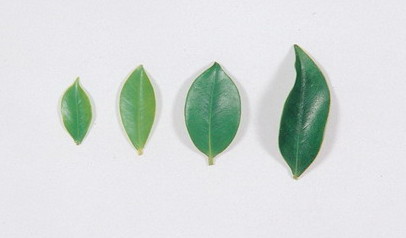
Fig. 6 |
The foliage shape is another
important factor. We can judge the Ficus species from leaf shape. As can
be seen in Fig. 6, the Ficus species that suitable for bonsai include
¡§Melon-Seed¡¨, ¡§Kim-Men¡¨, and ¡§Medium¡¨. |
¡§Melon-Seed species¡¨:
The leaf is small, flat, bright green, and always surround to each other like
clouds. It grows slowly, thus, it is suitable to be a small-scale bonsai or to
be used to modify large-leaf species.
¡§Medium-leaf species¡¨
Some of the medium-leaf banyans are quality species. Their leaf is flat and
thick, medium size, bright green to dark green in color. Their aerial root is
rich with good adhesion. We can often see beautiful medium-leaf banyans in some
important exhibitions.
¡§Kim-Men species¡¨
The leaf is flat and small, bright green in color. Their trunk grows speedily,
easy to cultivate and often covers with white gray dots. Their branches extend
smoothly. Branching doesn¡¦t take place on the same point. Hence, branches
trimming are easy to achieve. Besides, it is easy to cultivate, so we must
prevent fatting as possible when fertilizing. |
|
¡@ |
¡@ |
|

Fig. 7 |
All these three main categories can be obtained by layering (see
Fig. 7) or transplanting. Plants from these two approaches are same with origin
parent. The quality is stable and robust. On the other hand, it is known that
seeding method can propagate also. We don¡¦t recommend this way because we must
take the risk of mutation. Kim-Men banyan can be cultivated by circular peeling
method. After circular peeling, the root can grow spontaneously in sand. About
one month later, we treat the roots and replant it into another flowerpot. The
banyan will grow a good twisted roots and intricate gnarls. For the other two
species, layering combing with water plants covering will have a better survival
rate.
¡@ |
|
¡@ |
¡@ |
|
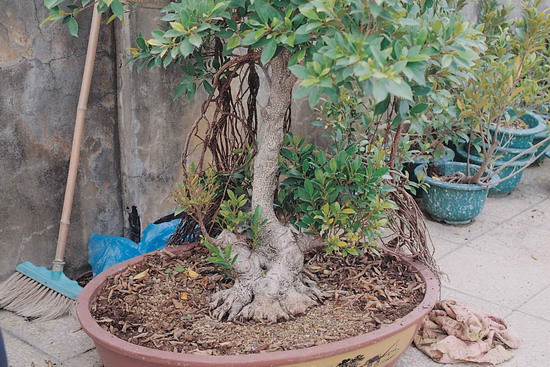
Fig. 8 |
The cultivating of Ficus bonsai must start from plantlet in a
culture pot (diameter about 1 foot 6 inches ¡V see Fig. 8). After a period of
time, we can transfer the plant to a larger flowerpot step-by-step if need. In
this way, the banyan will grow gracefully. In contrary, if we cultivate the
Ficus directly in farmland, it will develop coarsely, and difficult to train to
be a nice bonsai. |
|
¡@ |
¡@ |
|
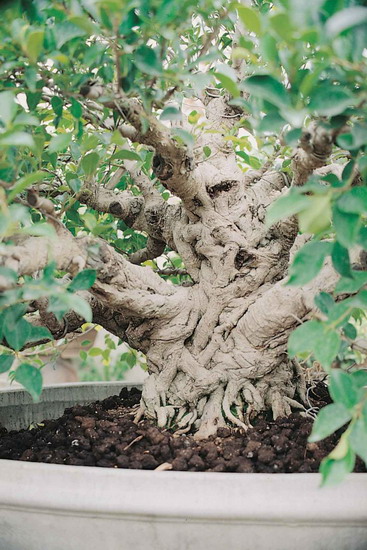
Fig. 9 |
Here, we describe how to
cultivate banyan in flowerpot. Ficus is a semi-aerial-root plant. The
aerial roots easily attach on its trunk or branches, and then melt into
(a proper phrase: bind or combine with) the trunk and to be one part of
the main trunk (see Fig. 9). As can be seen in Fig. 10, a proper
cultivating technique is to fertilize in previously and let it grows
freely in the initial stage. The aerial root will develop naturally
under the assist of fertilizer. Then, trim and integrate the whiskery
roots; let them attach along with the trunk. A few years later, as can
be seen in Fig. 11, it will exhibit like a giant banyan. That is, the
root and trunk integrate to each other. Pruning root is a routine work;
it must be done year-by-year. The time for training root depends on what
you like to create. The banyan in Fig. 12 shows the case for root
melting. In order to further train the planar root to be a hillock one,
author tries to dig out the planar roots, and to form some trenches even
in the stage of cultivating branches. The result is it will demonstrate
an excellent root act in future. If we must cut off some floating root
while pruning, we ought to do in the period of well growth, and plan the
tree shape we like in future.
¡@ |
|



Fig. 10 ~ Fig. 12 |
|
¡@ |
¡@ |
2. Cultivation for Semi-Finished Banyan
The important issues for cultivating plantlet are to predict and
determine the final tree shape, height, size, where to branch and so on.
Once the semi-finished banyan is grown up, many defects emerge. Thus, we
must solve them step-by-step. In this stage, higher techniques are
needed. Please read the followings for detail.
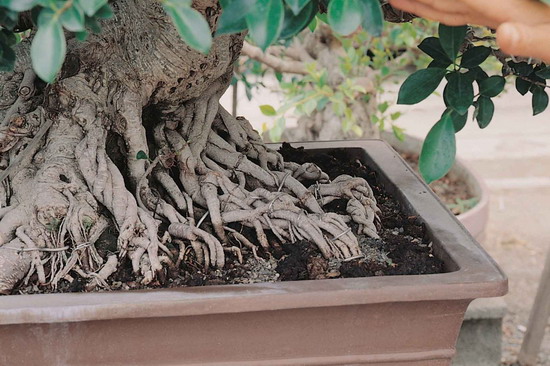
Fig. 12-1
(1) The Roots
The technique for ruling random roots is to select and reserve the roots
we desire; cut off the lateral root we dislike. Rope roots to create
stereo root art (see Fig. 12-1). If we do that, we can obtain the root
like Fig. 3.
As mentioned above, the nature banyan root can form hillock-root,
tumor-root and bar-root. If you observe the root particularly, you will
find the roots spread like branches. The root has many different
postures: protruding vs. concaving, deep vs. shallow, thick vs. thin.
They separate from a thick one to thin one. Roots have some main streams
as well as some specific ratio to hold on the land. We must note these
details when creating. If not, we will cultivate a featureless root,
that is, the roots are with almost the same size. Figure 13 shows a
beautiful example of harmonious root art. The root is cut from
generation to generation, and from inner to outer. After such careful
training, the root can show its own age. In addition, the artist must
note the ratio between trunk and root. In other words, the root must
match up its trunk, otherwise; too emphasis the root will lose the
whole.


Fig. 13 & 14
How to improve the fat root (see Fig. 14)? How to adjust
the root-trunk ratio? The first approach is as indicated in Figs. 15 and
16. We can divide the thick root into two or three parts, dig out the
lower part wood, and then press the upper part down. We must arrange the
height of each divided root when press down, or else, the roots will
grow inertly. This technique has beneficial effects on thinning roots,
especially for banyan. If we can apply this dig out technique flexibly,
we can solve most defects of banyan bonsai.


Fig. 15 & 16
Another approach is cut all thick roots off, and
replant or re-cultivate the root, as can been seen in Figs. 17 and 18.
In Fig. 17, the right-side root has been cut. The key point of this
technique is to cultivate the roots and branches simultaneously. Only by
this way, the root growth can be enhanced by branches. If we don¡¦t need
to cultivate thick roots, this technique is not suitable.


Fig. 17 & 18
Connecting roots: this technique can be applied to the banyan with less
aerial root. Utilize its or other banyan¡¦s unattached aerial roots to
connect with the main trunk (see Fig. 19). This technique has only a
limited modification effect, and thus, can be used to the finished
bonsai.

Fig. 19 |

Fig. 20 |
(2) The Trunks
The trunk is a critical factor determining the style of the whole tree.
For Ficus, it always grows with one main trunk or tufted trunks in
nature. It¡¦s trunk separates earlier than other tree. In general, the
trunk is covered with aerial roots. Like a standard broadleaf tree, it
extends laterally to form an umbrella-like crown. The ratio of leafy
shade and trunk is even larger than 10. If we follow this aspect ratio,
the bonsai will show like a young growth instead of an aged one.
The ratio more than 10 is for a distant prospect. For
instance, when we observe banyan for a long distance (see Fig. 21), it
seems the thin trunk is not compatible with its large crown. However, if
we get closer to the same tree and even under its shade, another
prospect will show us - the trunk becomes majestic and aged. The art of
bonsai, and the spiritual of banyan are demonstrated.
The creation of banyan bonsai is to refer to the ratio of root, trunk,
and branch in a close prospect; further capture their graceful posture
and disregard the graceless part. Hence, the small but impressive bonsai
can be achieved. |
|


Fig. 21 & 22 |
|
¡@ |
¡@ |
Combining root and trunk is a specific characteristic of
banyan. If can utilize this characteristic exquisitely, we can create an
ideal but natural bonsai. It must be noted that the various style of
bonsai is a goal should target, we need to create different style of
bonsai.
Improve the bad trunk
As can be seen in Fig. 23, the main trunk and root are inferior. We
often find such bonsai in market. How to improve it? For this case,
improving the branching site and reconnection is the key point. After
reconnection, the branches will grow many aerial roots and they will
cover the trunk from top to bottom, thus, original dull trunk is
disappeared (see Fig. 11). Styling of single trunk must take the ratio
and the skin into account (see Fig. 9), since the base part of trunk is
a crucial factor to determine the tree size.
The dull trunk can be modified by covering aerial roots. Of course, the
defects also can be hided by connecting with suspending whisker root. Or
apply the dig out technique mentioned above for improving (see Fig. 24).
In short, root and trunk determine the quality of the bonsai, so we must
pay attention in training the trunk to get rewards.
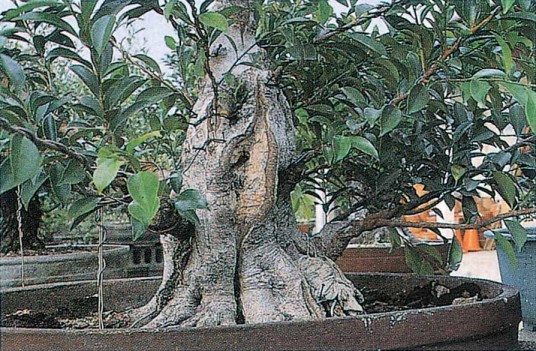

Fig. 23 & 24
(3) The Branches
The root and trunk is grown by branch. We know the separating point of
branch will directly influence the shape of root and trunk. It also has
an important effect on the bonsai style in future. The ¡§main branch¡¨
fabricates the main structure of the tree; the ¡§son branch¡¨ must to fill
the insufficient space left by main branch; and the ¡§grandson branch¡¨
must to fill the insufficient space left by the son branch etc. And thus
we must try to make the tree with luxuriant branches and leaves but
still in well spaced, as shown in Fig. 21.
Figure 23 demonstrates the tree with too few branches to be a basic
tree! It has trunk but without branches, like a person without limbs. We
graft and remove some branches for modification. The living branches of
Fig. 25 are transplanted to the poor one as seen in Fig. 26. After some
years later, a fairly good bonsai that exhibits a flowing branch art is
obtained. Moreover, the mending scar is invisible.
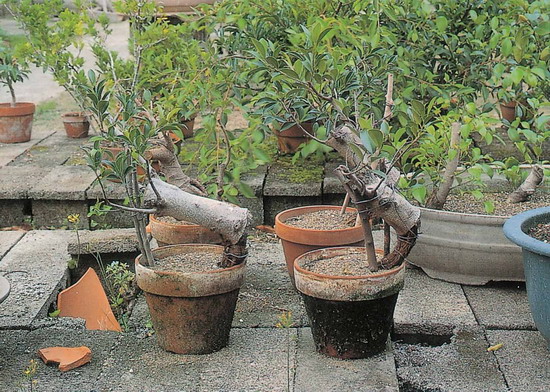
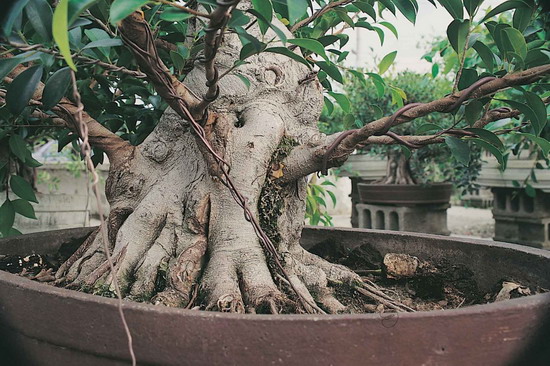
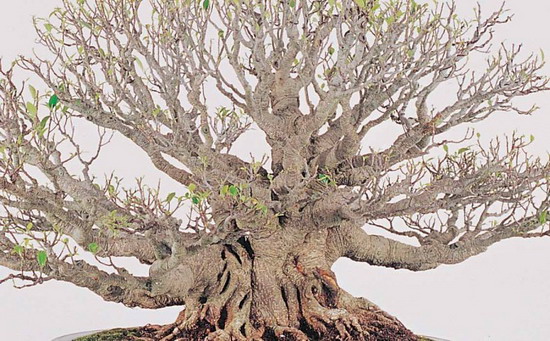
Fig. 25 ~ Fig. 27
Branch of the natural banyan dose not fix at the same place, the angle
always changes with time. The reason is xylem is soft but loads heavy
weight of the long branch. That is, the branch will droop year-by-year
in nature. However, for a bonsai, the branch is too short to bend itself
down. That is why a well-grown branch becomes upward rather than as a
nature one (to downward with time). As my experience, even a bended
branch will turn up with time. Thus, we must use cutting technique to
bend the branch step-by-step. Since the xylem is destroyed, we can
easily fix it after bending. A dull straight branch cannot be revised
simply by dragging method. In general, we should saw off some wood at
the inner side where we want to bend, then, drag-bend the branch till
the angle we like is reached.
Cutting-growing technique must prevent two or more branches grow at the
cutting site. It should propagate only one branch. If branch separating
is needed, it should far from the cutting site, either forward or
backward. If branch two or more at the cutting site, it will too fat to
compatible with branch art. Many bonsais make this mistake as shown in
Fig. 27-1.
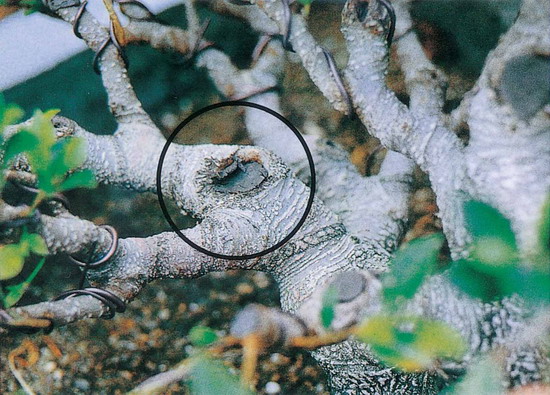
Fig. 27-1
Time for touch grafting
Although we can graft branches in either spring or autumn, spring is
much better. If one or two branches are not well growth after grafting,
touch grafting will result in failure.
The trunk and branches are propagating at the same time. When we want to
buy a plain bonsai, we should carefully observe the ratio of root, trunk
and branch. If the root and trunk is almost finished, however, the
branches are not well developed. After purchasing, we have to cultivate
the branches in addition. However, when branches grow as our
expectation, the trunks as well as the roots have over grown. In short,
we should hold discreet when choice a plain bonsai like that. Figure 22
indicates a standard banyan style in natural environment.
¡@
III. Maintenance
1. Maintain before Exhibition
The standard operation procedure for preparing exhibition is shown as
followings:
1. Before demonstration, you should finish the main structure of banyan,
and trim the minor branches at least twice to increase the total amount
of terminated branches. Branches will develop generally, and the foliage
will propagate densely as shown in Fig. 28. For sprouting successfully,
feed well 10 days before cutting down the leaves. It is very critical
for getting uniform and bright green leaves.
2. Remove the solid fertilizer and stop pouring one day before cutting
leaves. Cut leaves only when the soil is dry, since dry soil can
effectively eliminate the leakage of tree liquid, which is important for
tree vigor.
3. If you would like to demonstrate an evergreen type of banyan, cut the
leaves completely including sprouts. The newborn sprouts will grow
uniformly.
4. If you would like to demonstrate a cut-leaf type, cut all leaves one
week before exhibition and reserve all sprouts to show the vitality.(Fig.
29)
5. The time for cutting leaves must accommodate with the date of
exhibition. In general, we cut leaves 60~70 days before exhibition.
Consider the weather, tree size, and branches to adjust the cutting
days.
6. We start to fertilize when 2 or 3 leaves are opening. Fertilizing
should proceed gradually. Remember; don¡¦t feed too much one time,
otherwise, fertilizer will hurt roots or leaves.
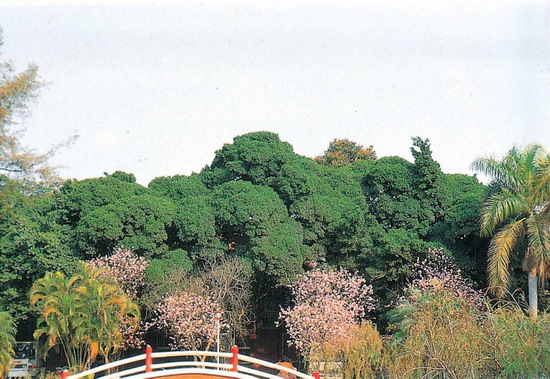
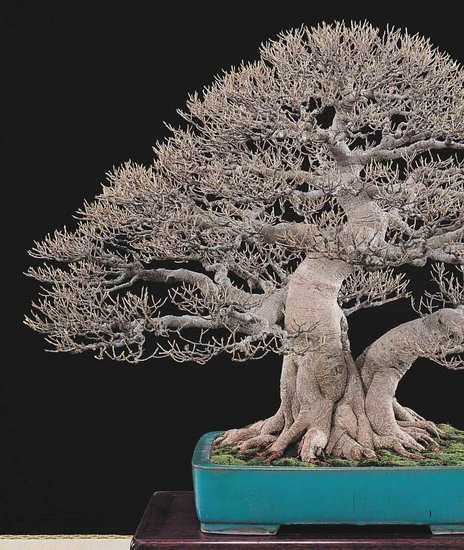
Fig. 28 & 29
2. Maintain a Finished Bonsai
If the bonsai has been finished for a long time, crown weaken is a
common problem. The inner branches degenerate less and less with time.
This is a specific phenomenon for banyan. For general plants, their top
sprout is always dominant in growing. Why banyan is different with
others? Because banyan is an aerial root plant, the nutrition is fed via
the easiest or shortest way, that is, the aerial root. The top of the
tree is far from ground, thus, the nutrition and water is fed less.
As illustrated in Fig. 30, we lead into some new aerial roots to
increase the paths for nutrition transport, and feed fertilizer to
recover the tree. Another approach is as shown in Fig. 31, we cut off
the leaves of tree-crown on one hand, but reserve the sprout on the
other. One week later, we further cut down the leaves and the sprout
sited on the lower branches. Every time, we cut leaves in this way, the
weaken crown problem will be solved gradually.

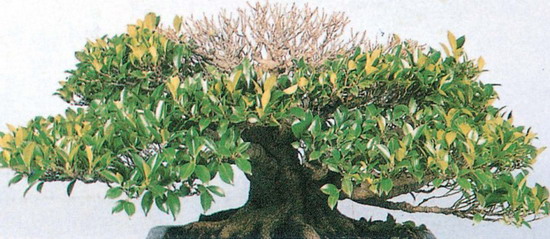
Fig. 30 & 31
Another point we shall note is we can find some aged banyan bonsais are
tend to transform. Delicate trunk is changing to be fat and dull. I have
asked some experts for further knowing the reasons and to propose the
strategy as following.
In Taiwan, a finished bonsai is often demonstrated, and thus the vigor
of tree is weakened. In order to modify the leaves to show a bright
green, a cultivator always utilize a larger container to cultivate.
Moreover, cultivator feed more water and fertilizer to increase the
vigor of tree. The vigor and leaf color is indeed improved but these
advantages always accompany with destroying the trunk and branch art.
Although feeding much soil and fertilizer have several benefits.
However, such cultivation method destroys bonsai art gradually. The
author has an aged banyan, which was sent to Japan for Kokufu
exhibition. After exhibiting, author had fed this banyan for a long
period. Now, it is changed! Large container, a strong banyan will be;
small container, a weak banyan will be. All cultivators must select the
central harmony between these two extremes.
For summary, a cultivator can start from these two phrases: ¡§practice
makes perfect¡¨ and ¡§diligence is the means by which one makes up for
one's dullness¡¨. Trial in error and repeated practice will set up your
personal style in bonsai. In this paper, all techniques mentioned above
are the essential of the pioneers. Due to the capacity of publication, I
can only write some important parts down. If readers have any question
or know some better techniques, please do not hesitate to contact with
me.
¡@ |
|
¡@ |
SiDiao
http://www.sidiao.com/ |
|
¡@ |
¡@ |
|